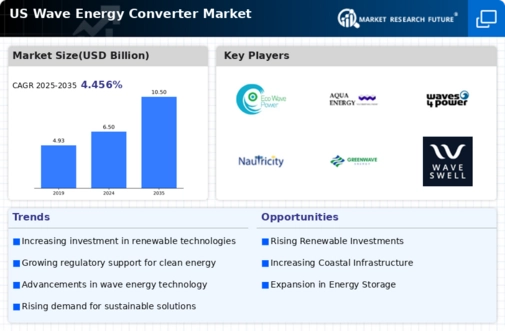Growing Demand for Renewable Energy
The increasing demand for renewable energy sources in the US is a primary driver for the wave energy-converter market. As the nation seeks to reduce its carbon footprint and transition to sustainable energy, wave energy presents a viable solution. According to the US Energy Information Administration, renewable energy consumption is projected to rise by 50% by 2050. This shift is likely to enhance investments in wave energy technologies, as they offer a consistent and reliable energy source. The wave energy-converter market is positioned to benefit from this trend, as utilities and energy companies look to diversify their energy portfolios and meet renewable energy targets. Furthermore, the growing public awareness of climate change and the need for clean energy solutions may further propel the adoption of wave energy technologies.
Advancements in Energy Storage Solutions
Advancements in energy storage technologies are likely to play a crucial role in the wave energy-converter market. As wave energy generation is inherently variable, effective storage solutions are essential for maximizing energy utilization. The development of high-capacity batteries and other storage systems can enhance the reliability of wave energy systems. For instance, the US Department of Energy has reported a significant decrease in battery costs, with prices dropping by over 80% since 2010. This trend may encourage the integration of wave energy systems with storage solutions, making them more attractive to investors and energy providers. Consequently, the wave energy-converter market could see increased adoption as these technologies become more economically viable and efficient.
Investment in Infrastructure Development
Investment in infrastructure development is a critical driver for the wave energy-converter market. The US government and private sector are increasingly recognizing the potential of marine energy resources. In recent years, federal funding for marine energy projects has seen a notable increase, with allocations reaching approximately $40 million in 2025. This financial support is likely to facilitate the construction of necessary infrastructure, such as wave energy farms and grid connections. Additionally, partnerships between public and private entities may emerge to accelerate project development. As infrastructure improves, the wave energy-converter market is expected to expand, providing more opportunities for energy generation and contributing to the overall growth of renewable energy in the US.
Technological Innovations and Research Funding
Technological innovations in wave energy conversion are a vital driver for the market's growth. Ongoing research and development efforts are focused on improving the efficiency and reliability of wave energy systems. The US government has allocated substantial funding for research initiatives aimed at advancing wave energy technologies, with investments exceeding $30 million in 2025. These innovations may include the development of more efficient converters and enhanced materials that can withstand harsh marine environments. As these technologies mature, they are likely to attract further investment and interest from energy companies. Consequently, the wave energy-converter market may experience accelerated growth as new solutions emerge, making wave energy a more competitive option in the renewable energy landscape.
Environmental Benefits and Sustainability Goals
The environmental benefits associated with wave energy are becoming increasingly recognized, driving interest in the wave energy-converter market. Wave energy systems produce minimal greenhouse gas emissions and have a lower environmental impact compared to fossil fuels. As the US aims to achieve its sustainability goals, the adoption of wave energy technologies may be prioritized. The Environmental Protection Agency has indicated that transitioning to renewable energy sources can significantly reduce air pollution and its associated health risks. This growing emphasis on sustainability may lead to increased funding and support for wave energy projects, thereby enhancing the market's growth potential. The wave energy-converter market stands to gain from this shift towards environmentally friendly energy solutions.



















Leave a Comment